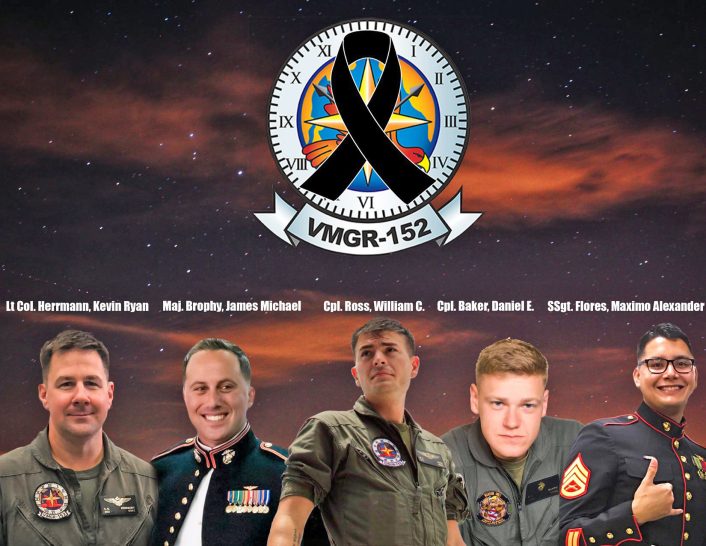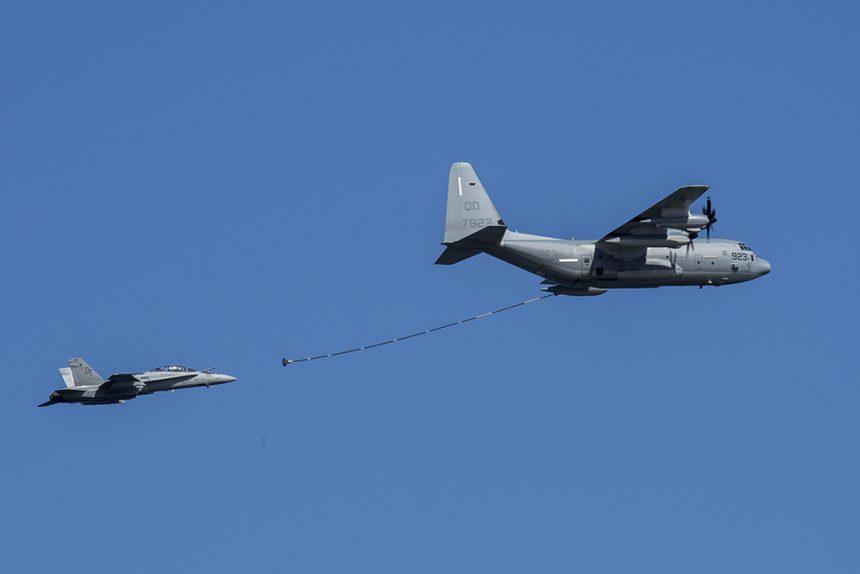Latest Accident Continues Tragic Trend, Underscores Risks of Marine Aviation.
“The cause of the crash is under investigation.” It is the boilerplate statement issued in the aftermath of every aviation accident. As U.S Marines maintain this response in the aftermath of another serious aviation accident off the coast of Japanese, the statement prompts an equally common media response, “There are more questions than answers at this time.”
Six U.S. Marines (including one of the two F/A-18D crew members) died on Dec. 6, in the seventh serious accident in Marine and Naval aviation this year, bringing the list of fatalities in Marine/Navy aircrews to at least 10. The number of aircraft lost in 2018 for the Marines and Navy is at least 8.
The Marine Corps identified the VMGR-152 crew members who died in the accident off Japan as Lt. Col. Kevin R. Herrmann, 38, of New Bern, North Carolina; Maj. James M. Brophy, 36, of Staatsburg, New York; Staff Sgt. Maximo A. Flores, 27, of Surprise, Arizona; Cpl. Daniel E. Baker, 21, of Tremont, Illinois; and Cpl. William C. Ross, 21, of Hendersonville, Tennessee.

Two aircraft were lost in this accident, a two-seat F/A-18D Hornet and a large, four-engine turboprop KC-130J Hercules bringing the number of aircraft lost to at least eight for 2018.
The aircraft lost were from Marine Aircraft Group 12 (MAG-12) stationed at MCAS Iwakuni. The unit includes F/A-18 Hornet unit, Marine All-Weather Fighter Attack Squadron 242 (VMFA-242) and KC-130J squadron Marine Aerial Refueling Transport Squadron 152 (VMGR-152). Iwakuni also is home to F-35B Joint Strike Fighter Squadron, Marine Fighter Attack Squadron 121 (VMFA-121), Marine Aviation Logistics Squadron 12 (MALS-12) and aviation ground support unit Marine Wing Support Squadron 171 (MWSS-171).
Statistics about Navy and Marine accidents are increasingly reported by journalists in guarded language, with careful disclaimers like, “at least”. Part of the reason for this accounting is sometimes unverifiable accident statistics available in the public space because of an early October change to the Naval Safety Center Data Management web portal that previously published statistics for U.S. Navy aviation accidents. The crash statistics for U.S. Navy aircraft are no longer available for persons without military clearance. This change hinders reporters from publishing accurate statistics about cumulative aviation accidents within the U.S. Navy.
In an October 9, 2018 report for Popular Mechanics, journalist Kyle Mizokami wrote, “The data is still there, but civilians, including reporters, are restricted from seeing it. The Navy has placed the data behind a digital wall where only Common Access Card (CAC) holders have access. CACs are only available to active-duty military, military reserves, government contractors, and civilian DOD employees.”
It is important to maintain both security and analytical care in the investigation and reporting of all aviation accidents, and particularly military accidents. Concern arises when the need to maintain operational security and empirical accuracy in accident investigation and reporting is contrasted against any perceived increase in accident frequency. If the frequency of accidents appears to be accelerating, a case for more expedient investigation of accident origins could be made. Amid careful language to avoid inaccurate accident reporting, the obvious question of how to moderate accident frequency arises. Military aviation, and especially Marine/Naval aviation, is inherently dangerous. The tempo of operations may also be accelerating with tensions in the Pacific over Chinese/U.S. territorial limits rising. This increased tempo brings a statistically equivalent exposure to risk. More operations equals more accidents in a strictly mathematical relationship.
But reporting on accidents does occasionally diverge from repetitive directives to “avoid speculation”. In a December 12, Wednesday report published on necn.com the accident on December 6th is being referred to as a “collision”: “The U.S. military has identified five Marines who were declared dead after their refueling plane collided with a fighter jet last week off Japan’s southern coast.” Sections of this report on necn.com were attributed to the Associated Press, a media outlet known for maintaining standards of journalistic accountability.
A U.S. Navy video released into the public domain was published December 6, 2018 on YouTube by the U.S. Naval Institute. The video shows a computer simulation of the July 10, 2017 accident in which a U.S. Marine KC-130T, callsign “Yanky 72”, broke apart in flight killing 15 Marines and one sailor.
Noted defense and aviation journalists Valerie Insinna and Jeff Ziezulewicz published a report on the accident on Dec. 6, 2018 on MilitaryTimes.com. Narrator Jeff Martin analyses the accident in this video:
We won’t know what happened in this most recent, Dec. 6, 2018 tragedy that took place approximately 200 miles off the Japanese coast in the darkness of 2 a.m., until the official investigation is released. If there is a singular conclusion early on from this most recent loss of 5 Marines and 2 aircraft off Japan’s coast, it is the repetitive truism that military aviation is inherently dangerous. As operational tempo increases in an evolving threat environment it is within reason to observe a commensurate increase in accidents. But especially for families and friends of those lost along with service members and veterans, this analytical perspective does little to reduce the emotional weight of these tragedies.









